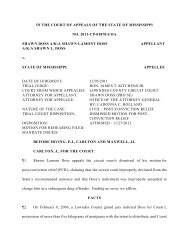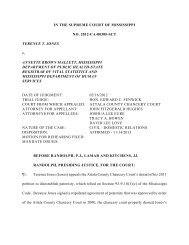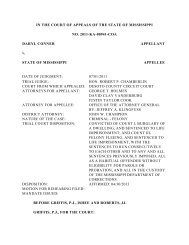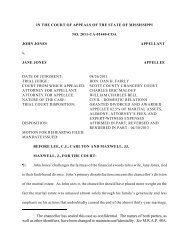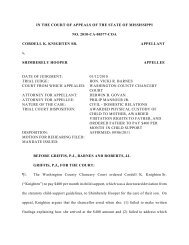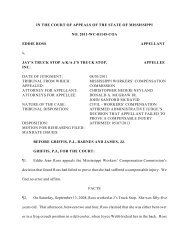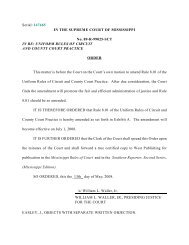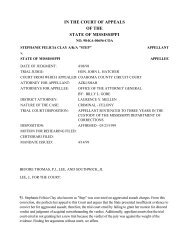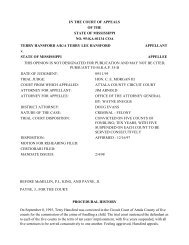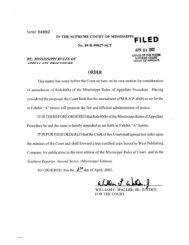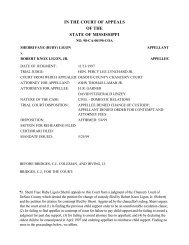2012-KA-01551-COA - Mississippi Supreme Court
2012-KA-01551-COA - Mississippi Supreme Court
2012-KA-01551-COA - Mississippi Supreme Court
You also want an ePaper? Increase the reach of your titles
YUMPU automatically turns print PDFs into web optimized ePapers that Google loves.
IN THE COURT OF APPEALS OF THE STATE OF MISSISSIPPI<br />
NO. <strong>2012</strong>-<strong>KA</strong>-<strong>01551</strong>-<strong>COA</strong><br />
ANTONIO CANNON<br />
APPELLANT<br />
v.<br />
STATE OF MISSISSIPPI<br />
APPELLEE<br />
DATE OF JUDGMENT: 06/18/<strong>2012</strong><br />
TRIAL JUDGE:<br />
HON. ALBERT B. SMITH III<br />
COURT FROM WHICH APPEALED: BOLIVAR COUNTY CIRCUIT COURT<br />
ATTORNEY FOR APPELLANT: AZKI SHAH<br />
ATTORNEY FOR APPELLEE: OFFICE OF THE ATTORNEY GENERAL<br />
BY: JEFFREY A. KLINGFUSS<br />
DISTRICT ATTORNEY:<br />
BRENDA FAY MITCHELL<br />
NATURE OF THE CASE:<br />
CRIMINAL - FELONY<br />
TRIAL COURT DISPOSITION: CONVICTED OF COUNT I, SALE OF<br />
COCAINE WITHIN 1,500 FEET OF A<br />
PUBLIC PARK, COUNT II, SALE OF<br />
MARIJUANA WITHIN 1,500 FEET OF A<br />
PUBLIC PARK, AND COUNT III, CHILD<br />
ENDANGERMENT, AND SENTENCED AS<br />
A HABITUAL OFFENDER TO THIRTY<br />
YEARS FOR COUNT I AND AS A<br />
HABITUAL OFFENDER TO THREE YEARS<br />
FOR COUNT II, AND AS A NON-<br />
HABITUAL OFFENDER TO TEN YEARS<br />
FOR COUNT III, WITH ALL SENTENCES<br />
TO RUN CONCURRENTLY, ALL IN THE<br />
CUSTODY OF THE MISSISSIPPI<br />
DEPARTMENT OF CORRECTIONS<br />
DISPOSITION: AFFIRMED - 12/10/2013<br />
MOTION FOR REHEARING FILED:<br />
MANDATE ISSUED:<br />
BEFORE GRIFFIS, P.J., ISHEE AND CARLTON, JJ.<br />
ISHEE, J., FOR THE COURT:<br />
1. In June <strong>2012</strong>, Antonio Cannon was convicted by a jury in the Bolivar County Circuit
<strong>Court</strong> of sale of cocaine and marijuana within 1,500 feet of a public park and of child<br />
endangerment. He was sentenced as a habitual offender for the sale of cocaine within 1,500<br />
feet of a public park to thirty years and for the sale of marijuana within 1,500 feet of a public<br />
park to three years, and as a non-habitual offender for child endangerment to ten years. The<br />
sentences were ordered to run concurrently, all in the custody of the <strong>Mississippi</strong> Department<br />
of Corrections (MDOC). On appeal, Cannon asserts that the circuit court erred in its failure<br />
1<br />
to properly handle his Batson challenge against the State’s peremptory strikes during voir<br />
dire; the evidence was insufficient to sustain his convictions; and the verdict was against the<br />
overwhelming weight of the evidence. Finding no error, we affirm.<br />
STATEMENT OF FACTS<br />
2. In August 2010, Jeffrey Boyd, a confidential informant, was wired by authorities with<br />
a hidden video camera and sent to Cannon’s mobile home to purchase illegal drugs. The<br />
home was located within 1,500 feet of Bear Pen Park – a public park in Cleveland,<br />
<strong>Mississippi</strong>. Cannon was at the home with his girlfriend, Jessica Twomey, and her four-yearold<br />
daughter.<br />
3. Boyd entered the home and asked Cannon for cocaine and marijuana. The videotape<br />
from Boyd’s hidden video camera showed Cannon exchanging cocaine and marijuana with<br />
Boyd for $60. Twomey and her daughter were present in the room when the exchange took<br />
place.<br />
4. Cannon and Twomey were later arrested, and the substances Cannon had given to<br />
1<br />
Batson v. Kentucky, 476 U.S. 79, 96 (1986) (holding it unconstitutional for either<br />
party to strike potential jurors for racially biased purposes)<br />
2
Boyd were retrieved and sent to a crime lab. The crime-lab expert who analyzed the<br />
substances testified that they were positively identified as cocaine and marijuana.<br />
5. Prior to the trial, the State and the defense were each granted six peremptory strikes<br />
during voir dire. The State’s strikes included six African American jurors. The defense’s<br />
strikes included five Caucasian jurors and one African American juror. The defense<br />
presented the circuit court with a Batson challenge, claiming the State had stricken the six<br />
African American jurors for racially biased reasons. The circuit court responded by noting<br />
that the majority of potential jurors in the jury pool were African American. The circuit court<br />
also pointed out that the defense had utilized five of its six strikes against Caucasian jurors.<br />
The circuit court then ruled against the defense in its Batson challenge, and the trial<br />
proceeded.<br />
6. At trial, the State presented three witnesses, including Boyd, and introduced numerous<br />
exhibits, including the videotape of the exchange, a photograph of the home, and<br />
photographs of the proximity of the home to Bear Pen Park. The State then rested its case-inchief.<br />
7. The defense moved for a directed verdict, which was denied. Cannon then indicated<br />
that he wished to waive his right to testify, and the defense rested without presenting any<br />
witnesses or evidence. The State and the defense made closing arguments, and the case was<br />
presented to the jury for deliberations.<br />
8. The jury returned a guilty verdict on all counts. The circuit court then sentenced<br />
Cannon. The defense did not file a motion for a judgment notwithstanding the verdict<br />
(JNOV) or a motion for a new trial. Cannon now appeals.<br />
3
STANDARD OF REVIEW<br />
9. A circuit court’s ruling on a Batson challenge “will not be overturned unless the<br />
record indicates the ruling was clearly erroneous or against the overwhelming weight of the<br />
evidence.” States v. State, 88 So. 3d 749, 754 (18) (Miss. <strong>2012</strong>) (citation omitted). With<br />
regard to issues relating to sufficiency of the evidence, the supreme court has stated that in<br />
considering the denial of a motion for a directed verdict, “the relevant question is whether,<br />
after viewing the evidence in the light most favorable to the prosecution, any rational trier<br />
of fact could have found the essential elements of the crime beyond a reasonable doubt.”<br />
Bush v. State, 895 So. 2d 836, 843 (16) (Miss. 2005) (quoting Jackson v. Virginia, 443 U.S.<br />
307, 315 (1979)). When reviewing challenges to the weight of the evidence, we “will only<br />
disturb a verdict when it is so contrary to the overwhelming weight of the evidence that to<br />
allow it to stand would sanction an unconscionable injustice.” Vaughn v. State, 926 So. 2d<br />
269, 271 (4) (Miss. Ct. App. 2006) (quoting Bush, 895 So. 2d at 844 (18)).<br />
DISCUSSION<br />
I. Batson Challenge<br />
10. In order to proceed with a Baston challenge, a defendant must make a prima facie<br />
showing that the State was motivated by race in its strikes. After proving a prima facie case<br />
of racially motivated strikes, “the burden shifts to the State to articulate a race-neutral reason<br />
for excluding [the] particular juror[s].” States, 88 So. 3d at 754 (19) (citation omitted).<br />
Here, Cannon asserts that the circuit court erred in its determination that Cannon did not<br />
present a prima facie case that the State’s strikes were racially biased.<br />
11. In order to establish a prima facie case, the defendant must show “(1) [he is a member]<br />
4
of a cognizable class, such as a racial group; (2) the prosecution used peremptory strikes to<br />
remove venire members in that class; and (3) the facts and circumstances give rise to an<br />
inference that the prosecution used peremptory strikes to purposefully remove individuals<br />
of that class.” Id. at 755 (21) (citing Batson, 476 U.S. at 96, 106 S.Ct. at 1712). The<br />
<strong>Mississippi</strong> <strong>Supreme</strong> <strong>Court</strong> has held that “[w]hen determining whether a defendant has<br />
established a prima facie case of discrimination, we must consider all relevant<br />
circumstances.” Id. at (22) (citations omitted). Furthermore, “a defendant can establish a<br />
prima facie case by demonstrating that the percentage of the State’s peremptory strikes<br />
exercised on members of the protected class was significantly higher than the percentage of<br />
members of the protected class in the venire.” Id.<br />
12. In States, the supreme court was faced with a Batson challenge, but was not provided<br />
specific information in the record with regard to the percentage of African American jurors<br />
in the venire. There, the supreme court quoted Birkhead v. State, 57 So. 3d 1223, 1230 (25)<br />
(Miss. 2011) in stating: “We cannot override the trial court when this <strong>Court</strong> does not even<br />
know the racial makeup of the venire or the jury.” States, 88 So.3d at 755 (24). Therefore,<br />
the supreme court in States found that the record was insufficient to overturn the circuit<br />
court’s decision. In doing so, the supreme court stated:<br />
Id. at (25).<br />
Likewise, we decline to reverse the trial judge’s decision in this case when we<br />
do not know the race and gender of the venire, the race and gender of the final<br />
jury, or the race and gender of the other potential jurors struck by the State.<br />
The presumption is in favor of the trial court, and the burden is on the<br />
appellant to demonstrate reversible error.<br />
13. The case at hand presents similar facts. The record is lacking as to the race and<br />
5
gender of the venire, the final jury, and the other potential jurors the State eliminated. The<br />
only information we have before us regarding the racial characteristic of the jury is seen in<br />
the circuit court’s notation that Caucasian jurors constituted the minority of the jury. We<br />
cannot find that the circuit court committed reversible error when we do not have before us<br />
a proper record showing the makeup of the venire, the jury, and the stricken jurors. This<br />
issue is without merit.<br />
II.<br />
Sufficiency of the Evidence<br />
14. Cannon next argues the evidence was insufficient to support his convictions. While<br />
making a motion for a directed verdict, Cannon’s defense counsel specifically argued that<br />
the evidence presented by the State was insufficient to support a finding that the sale of<br />
cocaine and marijuana was within 1,500 feet of Bear Pen Park. However, Cannon’s defense<br />
counsel failed to make any reference to Cannon’s argument on appeal that the evidence did<br />
not support a finding that Cannon was Twomey’s daughter’s “caretaker” under the statute<br />
of child endangerment. As such, Cannon’s argument is waived with respect to the childendangerment<br />
conviction. See King v. State, 897 So. 2d 981, 994 (39) (Miss. Ct. App.<br />
2004) (holding motions for a directed verdict must be made with specificity and motions<br />
generally challenging the sufficiency of the evidence without specific grounds serve as a<br />
procedural bar for issues on appeal grounded in claims of insufficient evidence).<br />
15. Hence, Cannon’s only valid argument on appeal with regard to sufficiency of the<br />
evidence is his defense counsel’s claim that the State failed to prove that the sale of cocaine<br />
and marijuana occurred within 1,500 feet of a public park. At trial, the State presented<br />
photographs showing the proximity of the home to Bear Pen Park, and presented witnesses<br />
6
who testified regarding the home’s nearness to the park. The defense failed to present any<br />
evidence or testimony contradicting this evidence. Accordingly, we find that any rational<br />
trier of fact could have found that the sale of cocaine and marijuana occurred within 1,500<br />
feet of Bear Pen Park. This issue is without merit.<br />
III.<br />
Weight of the Evidence<br />
16. Finally, Cannon challenges the weight of the evidence with respect to his convictions.<br />
However, we have held that “the failure to file a motion for a new trial bars raising this issue<br />
on appeal. There are certain errors that must be raised in front of the circuit judge in a<br />
motion for a new trial, including challenges to the weight of the evidence.” Davis v. State,<br />
75 So. 3d 569, 572 (14) (Miss. Ct. App. 2011) (citations omitted). Cannon did not file a<br />
motion for a new trial prior to raising this issue on appeal. Thus, this issue is procedurally<br />
barred.<br />
17. THE JUDGMENT OF THE BOLIVAR COUNTY CIRCUIT COURT OF<br />
CONVICTION OF COUNT I, SALE OF COCAINE WITHIN 1,500 FEET OF A<br />
PUBLIC PARK, COUNT II, SALE OF MARIJUANA WITHIN 1,500 FEET OF A<br />
PUBLIC PARK, AND COUNT III, CHILD ENDANGERMENT, AND SENTENCE AS<br />
A HABITUAL OFFENDER TO THIRTY YEARS FOR COUNT I , AS A HABITUAL<br />
OFFENDER TO THREE YEARS FOR COUNT II , AND AS A NON-HABITUAL<br />
OFFENDER TO TEN YEARS FOR COUNT III , WITH THE SENTENCES TO RUN<br />
CONCURRENTLY, ALL IN THE CUSTODY OF THE MISSISSIPPI<br />
DEPARTMENT OF CORRECTIONS IS AFFIRMED. ALL COSTS OF THIS<br />
APPEAL ARE ASSESSED TO BOLIVAR COUNTY.<br />
LEE, C.J., IRVING AND GRIFFIS, P.JJ., BARNES, ROBERTS, CARLTON,<br />
FAIR AND JAMES, JJ., CONCUR. MAXWELL, J., CONCURS IN PART AND IN<br />
THE RESULT WITHOUT SEPARATE WRITTEN OPINION.<br />
7



